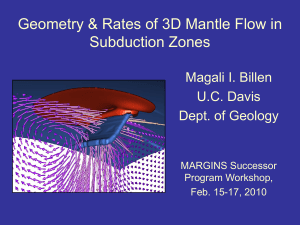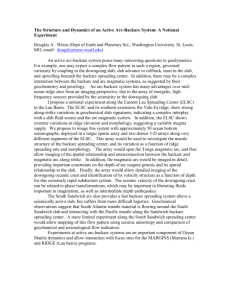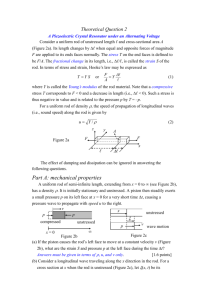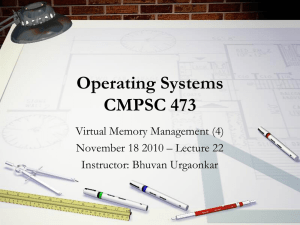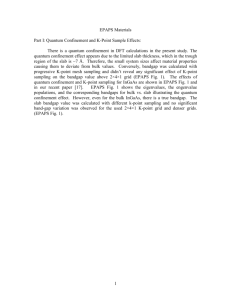11. Reflection/Transmission spectra
advertisement
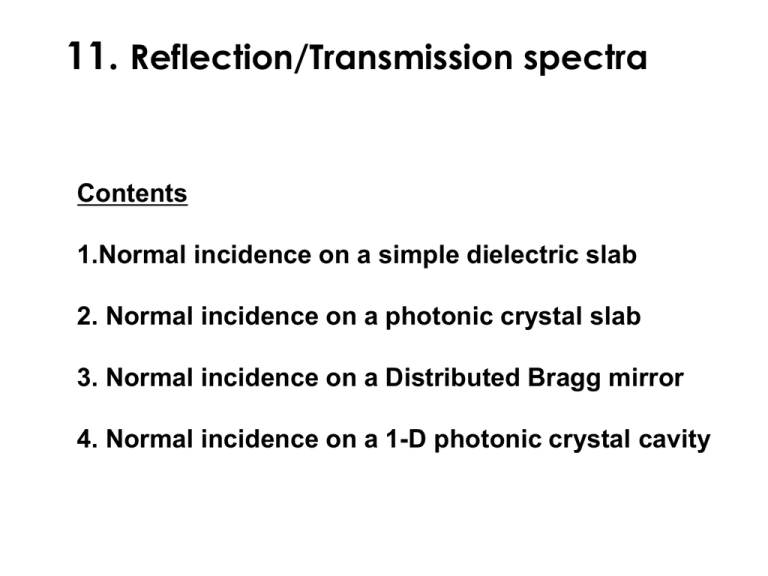
11. Reflection/Transmission spectra Contents 1.Normal incidence on a simple dielectric slab 2. Normal incidence on a photonic crystal slab 3. Normal incidence on a Distributed Bragg mirror 4. Normal incidence on a 1-D photonic crystal cavity 1. Simple dielectric slab 8 Without slab 6 Hx field Planewave source 4 2 0 -2 -4 -6 -8 0 2000 4000 6000 8000 10000 FDTD time step Slab (T=1a) 6 With slab Detect Hx field 4 2 0 -2 -4 -6 0 2000 4000 6000 FDTD time step 8000 10000 We will not use DS in this example DD shouldn’t be this much long because the simple Fabry-Perot slab does not have a high-Q resonance. As we can see from the field data, DD may be set 4000. (1,1) may be set (0.1, 0.1). Gamma point periodic boundary condition. The use of the planewave source ensures that the result will be only for the exact kx=ky=0 point. Two point detectors were set, one after the slab and the other between the planewave source and the slab ** How to obtain R & T spectra 1) We now have modeR.dat and modeT.dat 2) We must run another simulation in the absence of the dielectric slab. Then, we get modeR0.dat and modeT0.dat, which will be used as reference data. 3) Let’s denote modeR.dat = R(t) modeT.dat = T(t) modeR0.dat = R0(t) modeT0.dat = T0(t) (Important Node ) One must remember that the resolution of discrete FT will depend on the length of input data. We must add null values at the end of all ***.dat file before performing FT. I typically make the entire length of the input data file to be about 1 million (should be 2n format for accurate result) Now let’s perform the following calculations. FT[ R(t)-R0(t) ] / FT[ R0(t) ] = Refelctance spectrum in w FT[ T(t) ] / FT[ T0(t) ] = Transmission spectrum in w ,where FT denotes Fourier Transformation. 1.0 1.0 0.8 0.8 Reflectance Transmittance Result 0.6 0.4 0.6 0.4 0.2 0.2 0.0 0.1 0.0 0.1 0.2 0.3 0.4 0.5 Normalized Frequency 0.6 0.2 0.3 0.4 0.5 Normalized Frequency 0.6 2. Square lattice photonic crystal slab We will not use DS in this example In this example, DD should be carefully chosen. The 2-D photonic-crystal slab may contain very high-Q resonances (See the Fan’s paper) You cannot change this (1,1) Two point detectors were set, one after the slab and the other between the planewave source and the slab 1.0 1.0 0.8 0.8 Transmittance Reflectance Result 0.6 0.4 0.6 0.4 0.2 0.2 0.0 0.0 0.2 0.3 0.4 Normalized Frequency 0.5 0.2 0.3 0.4 Normalized Frequency 0.5 3. Distributed Bragg Reflector PML PML GaAs AlAs z Planewave source 20 pairs of AlAs/GaAs Target wavelength = 950 nm Grid resolution ∆z = 2.5 nm Periodic boundary condition for x-y directions We will not use DS in this example You can change this as 0.1 In this example, DD should be carefully chosen. The time required to reach the steady-state could be longer than you initially thought. In this example, we will only get reflectance spectrum Result 1.0 - 10 pairs - 14 pairs - 20 pairs Reflectance 0.8 0.6 0.4 0.2 0.0 750 800 850 900 950 1000 1050 1100 1150 Wavelength (nm) Accuracy - 10 pairs - 14 pairs - 20 pairs Reflectance (Log) 1 Analytic expression R tanh2 m ln(n1 / n2 ) (at the Bragg condition) 0.95 0.9 m 0.85 900 920 940 960 Wavelength (nm) 980 1000 Exact FDTD 10 0.832424 0.83231 14 0.947996 0.94795 20 0.991636 0.99162 Errors less than 1 part per 10,000 ! 4. 1-D photonic-crystal cavity GaAs AlAs A cavity is formed by the two Bragg mirrors Result 1.0 Reflectance 0.8 0.6 0.4 0.2 0.0 800 850 900 950 1000 Wavelength (nm) 1050 1100 Single excitation (950nm) Ey field 3 QWs





